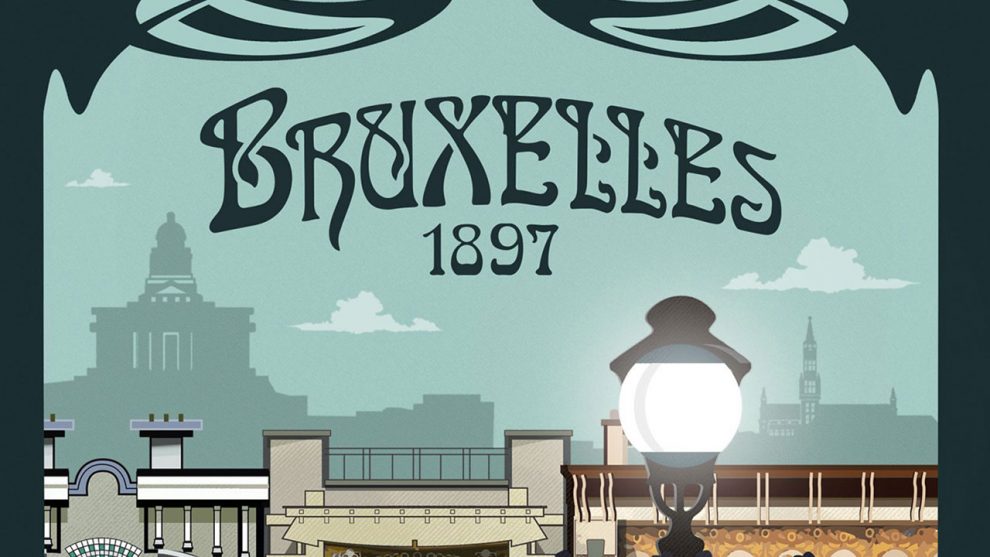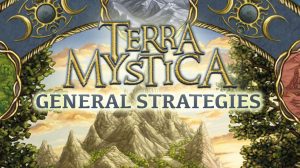Bruxelles 1897 is the card adaptation of Bruxelles 1893. The game centers around a card tableau known as the Art Nouveau Area. This area allows players to create and sell art, gather construction materials, build houses, hire Nobles, or hold an exhibition. Players compete over four rounds to score majority based points.
Hey, I’m Smash. You may have seen me in Ashley Gariepy’s reviews. Since Kathleen hasn’t played Bruxelles 1893, I’m here to offer insight on how Bruxelles 1897 differs from its predecessor.
Taking a Turn
On a player’s turn they can play one of the double-sided cards from their hand, known as Architects, to perform an action on the Art Nouveau Area (ANA) or the Brussels Area (BA). We’ll cover the ANA first.
Bruxelles 1893 also has both of these areas; in 1897 the start player doesn’t define the playing area of the Art Nouveau “board” — it will always be a predetermined playing area based on the number of players.
The Art Nouveau Area
On a player’s turn they can replace one of the cards in the ANA with one of their Architects. To do so the player must pay the value shown face-up on the Architect that they place. Architect cards have a high numbered side and a low numbered side, with prices ranging from 1-5 Belgian Francs (BEF). After paying, they then get to perform the card’s action. The five possible actions available in the ANA are:
- Creation: Take a piece of art from the ANA.
- Sale: Sell a piece of art that you currently possess for 3 BEF. Note that you still must pay the cost to place an Architect here, so you may end up losing money.
There is no Workshop cursor in 1897 so players don’t have the same control over the sale as they do in Bruxelles 1893.
- Supply: Take a material card from the ANA.
- Construction: Pay material(s) to build a House and score points depending on the number of different materials used.
This is one of the most important differences. In 1897 the type of required materials won’t change after each build and players won’t place their new house on the ANA — so there are no secondary (bonus) actions.
- Hire a Noble: There are 6 different Nobles that may be in the ANA, each with their own effect. When you hire a Noble, you gain their benefit immediately. You may choose to keep the Noble for future use, but you’ll have to pay them at the end of the game.
- Exhibition: Hold an exhibition. During an exhibition, starting with the player who initiated it and going clockwise, each player may exhibit a piece of art for two points. No two pieces of art in the exhibition can be the same. Unlike sales, exhibited pieces of art are not discarded. The exhibition ends when everyone has passed or all four colours of art have been exhibited.
Some of the tension and player interaction in Bruxelles 1893 that is lost with the revised Sale action in 1897 is made up for here with the Exhibition action.

The Brussels Area
Instead of placing an Architect in the ANA, a player can use the BA. This still requires the use of Architect cards, however, there is no monetary cost. There are three actions available in the BA:
- Stock exchange: Collect 5 BEF.
While this changes every round in Bruxelles 1893, it stays the same in 1897.
- City Hall: Activate one or more of your Nobles.
- Cinquantenaire Park: Perform an Art Nouveau action of your choice (except the Exhibition). There is no cost associated with this action.

Round Based Majority Scoring
At the end of each round, there are three majorities that are scored. First, the columns are scored. Whoever has spent the most in a column in the ANA (has the highest cumulative value of Architects in that column) will receive the bonus shown at the bottom of the column. There are 4 possible bonuses:
- Move up on the Prestige track: This track determines the points you get in the second phase of majority scoring.
- Move up on the Nobility track: This track determines how many of your Nobles you can activate at once.
- Move up on the Architecture track: This track determines how many points you get at the end of the game for your constructed Houses.
- Retrieve one of your Architects from Prison: Your highest valued Architect starts in the Prison and other Architect cards may end up there throughout the game.
In Bruxelles 1893 the winner of the column would then add the round’s bonus card as a multiplier to their end game scoring opportunities; this has been removed from 1897.
After the columns are evaluated, the Coat of Arms are scored. When an Architect card is placed in the ANA, it forms one-fourth of a Coat of Arms on each of its corners. Any completed Coat of Arms will score points for the player who contributed the most Architect cards (regardless of their value) to that Coat of Arms. The points received range from 1-3 depending on the player’s position on the Prestige track.

The last majority that is scored is the BA. The player who played the most cards to the BA must place one of those cards into the Prison and therefore has one less Architect to work with for the next round. Notably, all ties in the majority phase are “friendly” meaning more than one player can end up placing an Architect in Prison.
End of the Game
The game ends after four rounds. Players tally up their points based on what they received in game and these end game scoring conditions:
- Lose 3 points for each Noble you cannot pay (2 BEF each).
- Gain points for each of your constructed Houses based on your position on the Architecture track.
- Gain 1 point for each unused material card.
- If a player possesses the Exhibition card, they gain 2 points.
- Gain points based on column majorities.

This last point is the only one that isn’t self-explanatory. At the end of the game columns are scored the same way as they are during the Majority phase but this time for end game points. Players who have the majority in a column will gain points for the number of BEF, different pieces of art, different Houses, and Nobles that they possess.
This last point of end game scoring is how 1897 compensates for eliminating the bonus cards won each round.
Thoughts
I love a small box game and there is only one thing about the physical design of this game that I have a problem with. The game board needs to be unfolded at the start of each game. While this is normal practice for board games, this board is so small and with so little weight on it that it doesn’t easily lay flat. It could have easily just been two or even three individual boards instead of one folded one and this problem wouldn’t exist.
For a game about art, I’ll also mention that the box isn’t the prettiest. It’s not ugly, but they seemed to want to reuse as much as the card artwork as possible, making it overall a little cramped. I think this is a case where less is more. Much like its predecessor, the game stays true to the art nouveau style. But this doesn’t really have anything to do with the gameplay, so let’s talk about that.

During my first playthrough of Bruxelles 1897 I felt a bit overwhelmed (but in a good way). I imagine I would have felt less overwhelmed if I had played Bruxelles 1893. However, having not played it allows me to say with confidence that you can enjoy Bruxelles 1897 without knowing anything about the game’s history. This small, card-based game gives players a surprising amount of options. One player may focus heavily on Houses and the Architecture track, another Artwork, and another Coats of Arms and the Prestige track. All of these paths could lead to victory.
The game has a luck-based element in which cards show up in the ANA that round, but there are also ways to mitigate this through the BA actions. There is only one card that there is no replacement for in the ANA, the Exhibition card. Since the ANA is randomly dealt from a collection of cards, the Exhibition card may not appear in the tableau. In one game I played, this card was only in the ANA in the first round and then never again. This hurt the player who had focused quite heavily on collecting different pieces of art.

Bruxelles 1897 isn’t as dynamic as its predecessor and the state of the game won’t change as dramatically from turn-to-turn as it can in Bruxelles 1893 — the required materials, the defined playing area, and the value of a work of art, for instance.
To address player count, the ANA scales down with more players. There are 4 fewer cards in the tableau in a 3-player game than a 4-player one. Interestingly enough, there are the same number of cards in a 2- and 3-player game in the ANA, but 2 spaces are already occupied by an Architect card from an inactive player. Normally I like to play a game at all player counts before writing a review. However, due to current circumstances I can only comment on the differences between 2- and 3-player games. The addition of two Architects in the 2-player game limits the options a bit and also provides one-fourth of a Coat of Arms. I found that the scaling worked well to keep the game tight, however, there were more opportunities for tied majorities in a 2-player game. This meant that a 2-player game had higher scores than a 3-player game.
While Bruxelles 1893 is a much more interactive Euro game, what 1897 loses in player interaction it makes up for in a much quicker, more streamlined experience; one that preserves the essence and a lot of the original gameplay.
Overall, I’m quite pleased with the complexity of Bruxelles 1897. It’s a medium strategy game in a light game box, which I find delightful. The gameplay encourages players to have a long-term strategy, while requiring them to play tactically to achieve majority scoring each round. I’d recommend this to anyone who is looking to add some more variety to their collection without giving up too much real-estate on their board game shelves.
Six Month Update
Due to the Covid-19 Pandemic and restrictions on social gatherings this game hasn’t made it to the table again since the review. This is not a reflection of my feelings towards the game, and I hope to get it back on the table once board games have become a regular part of my life again.












This looks very interesting. I may have to check this out, as well as the game on which it is riffing.
Thank you Meeple Mountain
Etienne Espreman